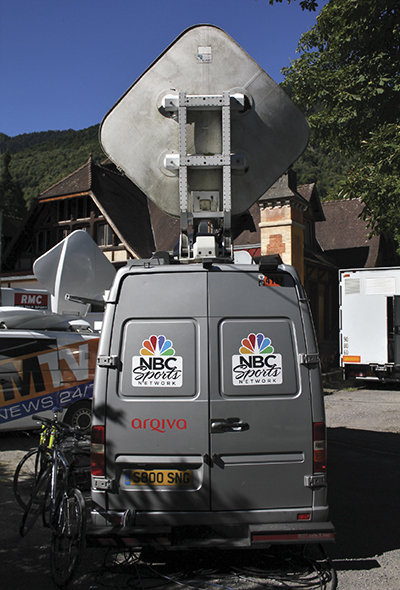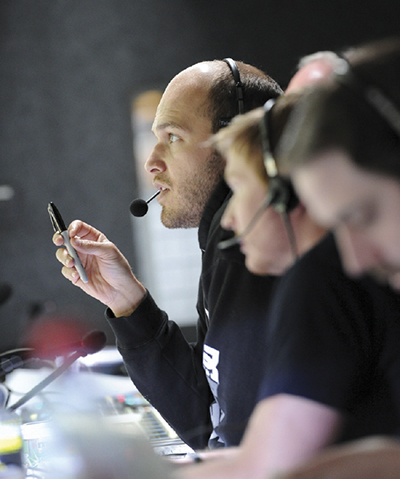NBC Takes Viewers on ‘Tour’

NEW YORK—This year is the 100th running of the Tour de France, one of the world’s most grueling and prestigious races. Always popular in Europe, the Tour has been increasing in popularity in the U.S., perhaps helped by extensive coverage of the now disgraced Lance Armstrong, who last year was stripped of his several Tour wins.
With that controversy still fresh in people’s minds and increasing domestic interest in the event, NBC plans major coverage that includes an in-country staff of around 60 people. Another 20 will support the Tour at NBC Sports Group’s International Broadcast Center in Stamford, Conn.
Stretching out over 23 days and 2,165 miles, NBC needed production facilities that could move as the Tour itself pedaled furiously from stage to stage.
“NBC Sports Group will have three primary mobile units—a control/tape room, a moving studio set with three cameras and a gear/edit facility,” said the program’s producer Joel Felicio. “The studio has three cameras and will travel with the race. The studio module can be raised off of the back of the truck so it is elevated.”
Felicio, who has done some competitive cycling himself, helmed other big cycling events as a producer with Versus. Started as the Outdoor Life Network and owned by Comcast, Versus controlled the U.S. rights to the Tour de France.
With Comcast’s acquisition of NBC Universal in 2011, the two organizations’ cable channels were merged to create the NBC Sports Network (NBCSN), among others. The 2013 Tour de France broadcasts in the United States will be provided by NBCSN.

One of NBC’s trucks will provide satellite uplinking to its hub in Stamford, Conn.
The professional video industry's #1 source for news, trends and product and tech information. Sign up below.
NBC’S CENTERPIECE
The centerpiece of NBC’s Tour de France production is a mobile studio trailer that will move each day to the next location. Once on site, the studio portion can be elevated to provide clean shots of the finish line for each stage, as well as create an attractive background for the studio anchors.
NBC’s coverage will be hosted by Todd Harris, with Phil Liggett and Paul Sherwen supplying play-by- play and commentary. Adding spice to the network’s production is NBC Reporter Steve Porino, who will ride a motorcycle in and around the racers.
“Porino will observe the race and report what he sees, which may not have otherwise been on camera,” Felicio said. “He will also talk to riders and team directors to get direct information.”
Unlike more traditional sports events that take place in a single location—or at least in a location that doesn’t move—the Tour de France begins on June 29 and moves every day (except for two days off) until the racers cross the finish line on July 21. These locations are literally all over France, in a wide range of weather, altitude and convenience.
One of the big televised cycling events produced by Felicio was the 2011 coverage of the Tour of California. In an interview at that time, he discussed how producing a wide-ranging bicycle race differs from other sports.
“You have to strike the set at the end of the stage when you’re done and drive the production trucks to the next stage, which could be three hours away,” Felicio said. “You wake up early the next morning, and the crew has to set up the truck in a two-hour time frame, when, normally in the sports world, you would have a full day to set up. That’s what’s challenging about a bike race; you have to move your entire production every day.”
BEHIND-THE-SCENES
Video feeds of the actual race all come from a single behind-the-scenes organization. For the 2013 Tour de France, a local French company named World 2 will supply video and audio to all international broadcasters, who then add their own targeted coverage. NBC is further assisted in its coverage and logistics by the European-based Woods Sports Network.

Pierre Moossa will be NBC’s primary director for its Tour de France coverage.
With interest in cycle racing high in the U.S., NBC recently inked an agreement to carry the Tour de France for another 10 years.
“The Tour de France has long been one of the tent pole events on the NBC Sports Network schedule, and now will be an integral part of our NBC broadcast schedule, with live coverage each year,” said Jon Miller, president of programming for NBC Sports and NBC Sports Network.
For the 2013 Tour, NBC plans 295 total hours of coverage, including 19 of the 21 stages live on the NBCSN. Two stages (7 and 8) will be live on NBC’s over-the-air network, and NBC will average more than 13 hours of race action per day throughout the 21-stage competition on the NBCSN, including a nightly studio show.
Last year, NBC posted healthy gains in viewership from the previous year, with an overall 29-percent increase of audience size.
Weather is always a concern for the Tour de France, as racers can go from summer sea-level heat to snowy mountain passes on the same day. Of course, if the cyclists ride through snow, television crews will be there to capture the action. In some ways, the Tour de France is as grueling for broadcasters as it is for the cyclists, with a lot of running flat out from stage to stage and a race against the clock and the elements to get everything operating in time to provide the coverage.
As the broadcaster of the Olympics for the past several cycles, NBC has staked out a name in the world of international sports. With its highly visible pop-top mobile studio, the network should improve its visibility in cycling, one of the world’s most prestigious sports.
Bob Kovacs is the former Technology Editor for TV Tech and editor of Government Video. He is a long-time video engineer and writer, who now works as a video producer for a government agency. In 2020, Kovacs won several awards as the editor and co-producer of the short film "Rendezvous."

